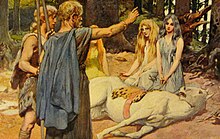Germanic paganism
This article may be expanded with text translated from the corresponding article in Danish. (February 2018) Click [show] for important translation instructions.
|
| Part of a series on |
| Heathenry |
|---|
 |
Historical Germanic religion |
Theory Theology and cosmology:
Clusters of deities |
Organisation
Religious institutions:
|
Spread
|
Sources
|

Emil Doepler's depiction of the Second Merseburg Charm, 1905. In the charm, gods from continental Germanic mythology heal a horse.
Germanic paganism refers to the indigenous religion of the Germanic people from the Iron Age until Christianisation during the Middle Ages. Rooted in Proto-Indo-European religion, Proto-Germanic religion expanded during the Migration Period, yielding extensions such as Old Norse religion among the North Germanic peoples, Continental Germanic paganism among the continental Germanic peoples, and Anglo-Saxon paganism among the West Germanic people. Among the East Germanic peoples, traces of Gothic paganism may be discerned from scant artifacts and attestations. According to John Thor Ewing, as a religion it consisted of "individual worshippers, family traditions and regional cults within a broadly consistent framework".[1]
Contents
1 Variations of Germanic paganism
2 See also
3 References
4 Further reading
Variations of Germanic paganism
- Anglo-Saxon paganism
- Continental Germanic paganism
- Frankish paganism
- Gothic paganism
- Old Norse religion
See also
- Heathenry (new religious movement)
References
^ Ewing, Thor (2008). Gods and Worshippers in the Viking and Germanic World. Tempus. p. 9..mw-parser-output cite.citation{font-style:inherit}.mw-parser-output q{quotes:"""""""'""'"}.mw-parser-output code.cs1-code{color:inherit;background:inherit;border:inherit;padding:inherit}.mw-parser-output .cs1-lock-free a{background:url("//upload.wikimedia.org/wikipedia/commons/thumb/6/65/Lock-green.svg/9px-Lock-green.svg.png")no-repeat;background-position:right .1em center}.mw-parser-output .cs1-lock-limited a,.mw-parser-output .cs1-lock-registration a{background:url("//upload.wikimedia.org/wikipedia/commons/thumb/d/d6/Lock-gray-alt-2.svg/9px-Lock-gray-alt-2.svg.png")no-repeat;background-position:right .1em center}.mw-parser-output .cs1-lock-subscription a{background:url("//upload.wikimedia.org/wikipedia/commons/thumb/a/aa/Lock-red-alt-2.svg/9px-Lock-red-alt-2.svg.png")no-repeat;background-position:right .1em center}.mw-parser-output .cs1-subscription,.mw-parser-output .cs1-registration{color:#555}.mw-parser-output .cs1-subscription span,.mw-parser-output .cs1-registration span{border-bottom:1px dotted;cursor:help}.mw-parser-output .cs1-hidden-error{display:none;font-size:100%}.mw-parser-output .cs1-visible-error{font-size:100%}.mw-parser-output .cs1-subscription,.mw-parser-output .cs1-registration,.mw-parser-output .cs1-format{font-size:95%}.mw-parser-output .cs1-kern-left,.mw-parser-output .cs1-kern-wl-left{padding-left:0.2em}.mw-parser-output .cs1-kern-right,.mw-parser-output .cs1-kern-wl-right{padding-right:0.2em}
Further reading
Grimm, Jacob (2004), Teutonic Mythology, translated by Stallybrass, James S., Dover Publications
Buchholz, Peter (1968), "Perspectives for Historical Research in Germanic Religion", History of Religions, University of Chicago Press, 8 (2): 111–138
North, Richard (1991), Pagan words and Christian meanings, Rodopi, ISBN 978-90-5183-305-8